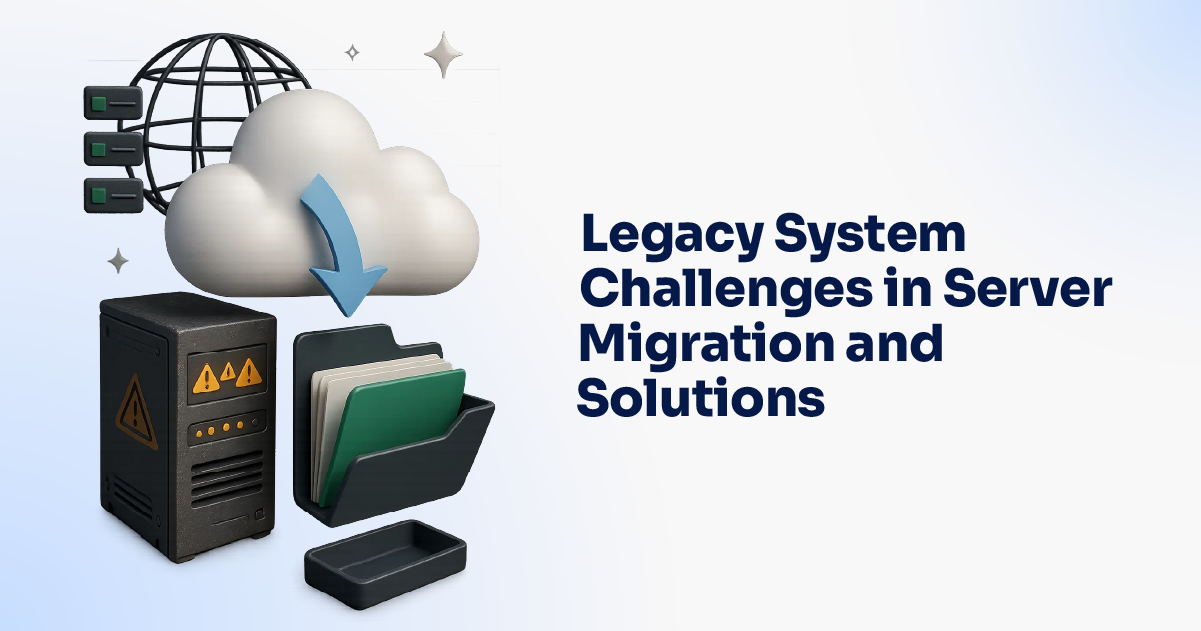
As businesses strive for agility, scalability, and cost-efficiency, migrating legacy systems to modern server environments has become a strategic priority. However, server migration, especially from outdated or unsupported legacy systems, is no walk in the park. These systems often hold decades of business logic, complex customizations, and critical data, making the migration process both technically and operationally challenging.
In this blog, we’ll explore the common challenges organizations face when migrating legacy systems and how to overcome them using effective strategies and the right Cloud Migration Services.
What Is a Legacy System?
A legacy system refers to outdated hardware or software that is still in use despite being replaced by newer technologies. These systems may no longer be supported by vendors, are expensive to maintain, and often lack compatibility with modern technologies. Yet, they remain critical to many business operations, making migration a sensitive and high-stakes process.
Key Challenges in Legacy System Server Migration
Here are some key challenges in Legacy System for server migration:
1. Complex Dependencies
Legacy systems are often tightly interwoven with other applications and databases. They have grown organically over the years, resulting in intricate dependencies that are poorly documented. Untangling these interconnections without disrupting services is one of the most significant challenges.
Solution:
Conduct a comprehensive dependency mapping exercise before the migration. Tools like Application Dependency Mapping (ADM) can help visualize and identify system interconnections. Engaging experienced Cloud Migration Services providers ensures that nothing falls through the cracks.
2. Data Integrity and Compatibility
Legacy systems may use outdated data formats or storage methods that are incompatible with modern servers or cloud platforms. Migrating this data while maintaining integrity, accuracy, and accessibility can be daunting.
Solution:
Start with a detailed data audit. Identify redundant, obsolete, or trivial (ROT) data and clean it. Use data transformation tools or middleware to convert old formats into compatible structures. Perform test migrations to validate data accuracy before full deployment.
3. Security and Compliance Risks
Legacy systems often lack the security protocols required by modern compliance standards like GDPR, HIPAA, or SOC 2. During migration, there is a risk of exposing sensitive data or creating vulnerabilities.
Solution:
Implement a robust security framework during migration. Encrypt data during transit, conduct risk assessments, and ensure the new environment complies with regulatory standards. Involve security experts from the planning stage to post-migration auditing.
4. Downtime and Business Continuity
Legacy migrations can take time, and extended downtimes are not acceptable in most industries. Maintaining business continuity during server migration is a delicate balance.
Solution:
Adopt a phased migration or hybrid approach. Use replication and synchronization techniques to keep both environments live during the transition. Schedule migrations during off-peak hours and prepare rollback plans in case issues arise.
5. Lack of Documentation
Many legacy systems are poorly documented or maintained by developers who are no longer with the organization. This lack of insight can lead to unforeseen errors during migration.
Solution:
Invest in reverse engineering tools and code analysis to understand the system architecture and functions. Engage IT staff familiar with the legacy system, if available, or consult with experts who specialize in such environments.
6. Skill Gaps and Resistance to Change
In-house IT teams may lack the skills required for modern server or cloud environments. Additionally, users accustomed to legacy interfaces may resist changes, impacting productivity post-migration.
Solution:
Train your team in modern technologies or partner with a cloud migration provider. Use change management strategies to communicate the benefits, offer user training, and provide continuous support to smooth the transition.
7. Cost Overruns
Legacy migrations can become expensive if not properly scoped and managed. Hidden costs, scope creep, and prolonged timelines can result in significant budget overruns.
Solution:
Create a detailed migration roadmap with clear timelines, milestones, and budgets. Conduct a cost-benefit analysis and prioritize critical workloads. Working with an experienced partner helps reduce trial-and-error costs and ensures a more predictable ROI.
Best Practices for a Successful Legacy System Migration
Here are some of the best practices to follow:
- Assessment First: Evaluate your current system thoroughly before starting. Understand which components are worth migrating and which can be retired or replaced.
- Start Small: Begin with non-critical workloads to test your migration strategy and build confidence.
- Leverage Automation: Use automation tools for data transfer, configuration management, and testing to save time and reduce human error.
- Engage Experts: Migration is not a DIY project. Trusted providers bring expertise, tools, and methodologies to ensure a smooth and secure migration.
Conclusion
Migrating legacy systems to modern servers is a complex yet essential step toward digital transformation. While the challenges are real—from data incompatibility to system downtime—they can be addressed with strategic planning, skilled execution, and the right partners.
Whether you’re moving to a private, public, or hybrid cloud environment, leveraging professional Cloud Migration Services can simplify the journey and reduce risks. With the right approach, your business can unlock the benefits of agility, performance, and cost-efficiency that modern infrastructure offers—without leaving your legacy behind.
